News
One side has water, the other is denied
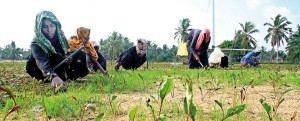 The drought setting in is set to create a major water crisis, particularly for farmers as they prepare for the coming Yala cultivation season.
The drought setting in is set to create a major water crisis, particularly for farmers as they prepare for the coming Yala cultivation season.
Water levels in tanks and reservoirs are dropping.
A visit to the Kurunegala and Puttalam districts provided a glimpse of the hardships faced by the farmers and residents.
The ancient Hakwatuna Oya reservoir lies some 45km from Kurunegala town and is the second largest in the province after the Deduru Oya reservoir. Constructed by King Mahasen in the 4th century AD, Hakwatuna Wewa was restored by the Irrigation Department in 1964. There are 14 divisions of farmer settlements in the area and a total population of about 30,000.
When the Sunday Times visited the Hakwatuna Oya area this week, farmers were holding their harvest festival, or Aluth Sahal Mangalya.
This gathering, in the shadow of the Hakwatuna Oya reservoir, was significant for another reason: farmers’ representatives of all 14 divisions, and local officials from the Irrigation Department had gathered there to reach an agreement on when to open the sluice gates of the reservoir to enable paddy cultivation for the Yala season.
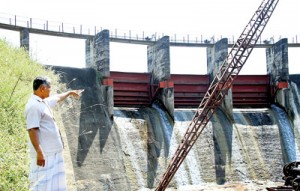
A Farmer points to the sluice gates of the Hakwatuna Oya reservoir that had several leaks. Pix by Indika Handuwala
Officials and farmers had both expected rains by the end of March. “We decided at the harvest season meeting on March 15 to release water to the farmers on March 25. We were working on the assumption that there would be several days of heavy rain in between. Unfortunately, there hasn’t been any rain up until now,” said P.K. Sriyananda, Resident Project Manager of the Hakwatuna Oya Irrigation Scheme.
In the light of this situation, the officials told the farmers that water could only be released to one part of the Hakwatuna Oya Scheme. The meeting held after the Aluth Sahal Mangalya was meant to decide on which part that would be.
The irrigation engineer for Ibbagamuwa, P.M. Dashan Rathnayaka, who is in overall charge of the area, said after the meeting that a tentative decision had been made for water to be released along the left bank of the reservoir only.
“We will again hold a meeting with the farmers on March 28 to take a final decision,” he said, “but at this stage, depending on the rain situation, the plan is for farmers on the right bank to grow subsidiary crops while paddy will only be cultivated on the left bank.”
R.M. Dissanayake, President of the Joint Farmers’ Association of the Hakwatuna Oya scheme, represents all 14 farmers’ associations in the area. He said farmers were in agreement over the proposal to release water to only one bank.

Nikaweratiya: Deduru Oya running dry
“For the past five years, we have always experienced several days of heavy rain towards the end of March but this year we have got none. If water is released to both banks, it is doubtful whether there will be enough water to sustain us through the season. We can’t take that risk,” he explained.
While accepting that water would probably be available to only one bank, some farmers expressed frustration and claimed the government was making a bad situation worse due to confusion over the fertiliser subsidy.
“First they asked us to open bank accounts and fill out forms. Now they say the plan is to give vouchers. None of the lists for fertiliser subsidies have even been finalised,” fumed R.A. Premaratne, President of the Pahalagama Farmers’ Association. Other farmers said they supported the decision to give money in place of fertiliser but wished the system was more efficient, particularly now with a water crisis looming.
Farmers also showed us that the sluice gates of the reservoir had several leaks. The leakages had been present for nearly a decade, they told us, pointing out that at a time when the effects of a drought were just starting to show, it was irresponsible for precious water to go to waste in such a way.
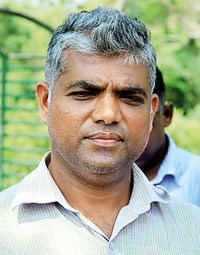
Engineer Rathnayake admitted he was not aware of the extent of the leakages as he had only assumed dutiesin January. Other Irrigation officials who were present insisted the leaking water was flowing to the anicuts, enabling it to be used for growing various subsidiary crops and, thus, wasn’t really going to waste.
“Now that the water level is dropping we will see if we can effect repairs to the sluice gates in the coming months. You have to realise, however, that this reservoir is more than 20 feet deep and it will be impossible to repair it using divers. The only way we can do it is by manually draining the water. This is out of the question in a drought situation,” Mr. Rathnayaka pointed out.
He also said the farmers who were on the right bank, denied reservoir water, would not suffer due to not being able to cultivate paddy because they were currently working on the World Bank-funded Climate Resilience Improvement Project in the area. He revealed that farmers’ associations were actively engaged in this project, aiming to rebuild the region’s canal system, which had not been renovated in 62 years.
The Sunday Times also visited Puttalam to see how vegetable growers were coping with the drought. Along the way, we got glimpses of how the effects of the drought were just starting to show.
In the Nikaweratiya area, we observed that the Deduru Oya was running dry. The local people did not have water problems yet, as tanks such as the Magalla Wewa were full.
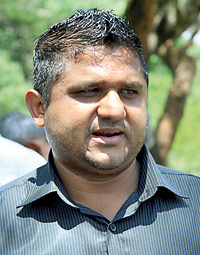
The irrigation engineer for Ibbagamuwa, P.M. Dashan Rathnayake
“The tanks are full and so far we have had no problems over drinking water or getting water for cultivation. The weather is dry though, and we hope some rain will come soon,” said a woman who maintained a fruit and vegetable stall on the side of the road.
In Norochcholai, Puttalam, we met young businessman Nisam ul-Haq who was overseeing work on his beetroot farm. Some distance away, a group of female workers were manually weeding the beds.
Mr. ul-Haq said he grew various kinds of vegetables and fruit on several plots of land he owned. “I’ve been doing this for the last seven years. There’s a big profit,” he revealed, noting that the crop is harvested within two months. People in the area grew all types of vegetables except for carrot and leeks, he said.
He acknowledged, however, that the dry weather was making things difficult. “We have to water the crops more. This is not like Nuwara Eliya. The temperature is high and it is a difficult climate in which to grow beetroot. Luckily, we all have a tube well and it is working fine so far.”
Mohammed Azwar, who works for Mr. ul-Haq, said he would normally water the crop twice on days where the heat was not oppressive. “But I water them five times a day for 20 minutes these days because of the dry weather. That uses up a lot of water,” he said.
Mr. ul-Haq was cautious about wishing for rain. “The rains last December destroyed most of the crops in this area. We obviously don’t want a repeat, but we don’t want it to be completely dry either,” he said.
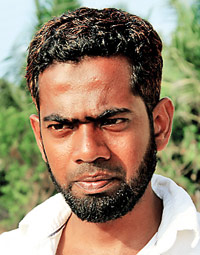
Nisam ul-Haq overseeing work on his beetroot farm where a group of female workers were manually weeding the beds. (above right)

